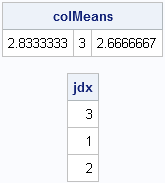In a previous blog post, I showed how to use the SAS/IML SORT and SORTNDX subroutines to sort rows of a matrix according to the values of one or more columns. There is another common situation in which you might need to sort a matrix: you compute a statistic for each row and you want to order the rows according to the value of that statistic.
For example, suppose that each row of the matrix represent a US state and the columns represent data about crimes. For each state (row), you can compute a measure of the severity of crime in the state. You might want to reorder the rows so that low-crime states are listed first and high-crime states are listed last.
The technique that I describe in this article is independent of the size of the matrix. Consequently, I illustrate the technique by using a small 6x3 matrix. The following SAS/IML statements define the matrix and use the mean subscript reduction operator (:) to compute the mean of each row:
proc iml;
x = {5 1 4,
1 5 1,
4 3 4,
2 4 3,
2 3 1,
3 2 3};
/** in general, compute ANY statistic for rows **/
rowMeans = x[,:];
print rowMeans; |

The printed output shows the mean for each row. You can use the SORTNDX subroutine to obtain the vector (idx) that sorts the means. If you use that vector as a row subscript for the x matrix, the resulting matrix is sorted according to the row means, as shown in the following statements:
/** get row numbers that sort the matrix **/ call sortndx(idx, rowMeans, 1); print idx; /** sort matrix by row statistics **/ y = x[idx, ]; |
Why does this work? The idx vector indicates that row 5 is the row that has the smallest mean, row 2 is the row that has the second smallest mean, and so on, down to row 3, which is the row that has the largest mean. Consequently, the expression x[idx, ] sorts the rows of x according to their mean values.
Although this example uses the mean of the rows, it is clear that you can reorder the rows according to the values of any statistic.
Reordering Columns of a Matrix
The technique also applies to reordering columns of a matrix. For example, suppose that you compute the means of each column of x. The following SAS/IML statements reorder the columns so that the column that has the smallest mean is first, and the column that has the largest mean is last:
/** compute mean for each column **/ colMeans = x[:,]; print colMeans; /** get col numbers that sort the variables **/ call sortndx(jdx, T(colMeans), 1); /** note T=transpose **/ print jdx; /** sort matrix by col statistics **/ z = x[, jdx]; |

Notice that the vector jdx is used as a column index for the x matrix. Except for that difference, these statements are essentially the same as the statements in the previous section.

1 Comment
Pingback: Ranking with confidence: Part 1 - The DO Loop